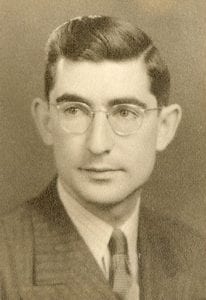 Arthur A. Slobod was the son of parents who immigrated from Czarist Russia around 1905. His father and uncle were 1910 graduates of The Ohio State University with degrees in engineering.
Arthur A. Slobod was the son of parents who immigrated from Czarist Russia around 1905. His father and uncle were 1910 graduates of The Ohio State University with degrees in engineering.
He graduated from Rensselaer Polytechnic Institute in 1931 with an engineering degree, sponsored there by a New York State Regents Scholarship. Finding engineering jobs to be difficult in the depression, he, too, came to The Ohio State University, earning a MS in Physics in 1932. As jobs were still difficult to find, he returned to Ohio State, earning a BS in Optometry in 1937. While there, he tutored many of his classmates in math and optics, including Robert Graham (BS’37). Graham founded a company Armorlite in 1947 that pioneered CR-39 (plastic) spectacle lenses. It was the sole provider of CR-39 resin in the world for 6 years. Slobod invested about $1000 in that venture in 1948.
As World War II began, the need for technical people was greater than the public’s desire for vision care, so Slobod returned to engineering, working for General Electric on the Manhattan Project in Berkeley, California, developing a highly refined uranium product for the eventual atomic bomb. He traveled with the Freedom Train in the late 1940s as it toured the country. Later employment with North American Aviation allowed him to work on the Minuteman Missile guidance systems and the Apollo missions.
The sale of Armorlite to 3M in 1978 gained him 18 000 shares of 3M stock, valued in excess of $1 million, allowing him to completely retire. He passed away on April 16, 2011, at the age of 100 years, 9 months. He is survived by his daughter, Beverly Slobod King, and his son, Clifford Slobod, two grandchildren, and three great-grandchildren.
Depending on the source, the atomic bomb and manned flight to the moon are two of the top American innovations/inventions. This notable alumnus spent a portion of his life working on each of them.
